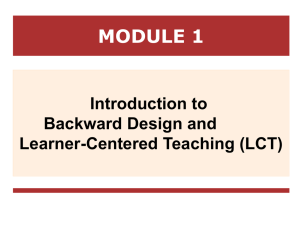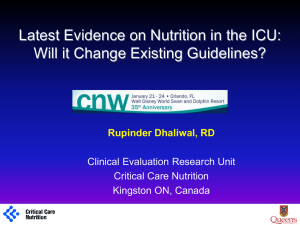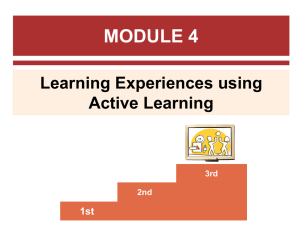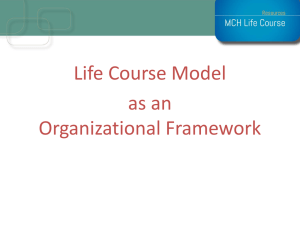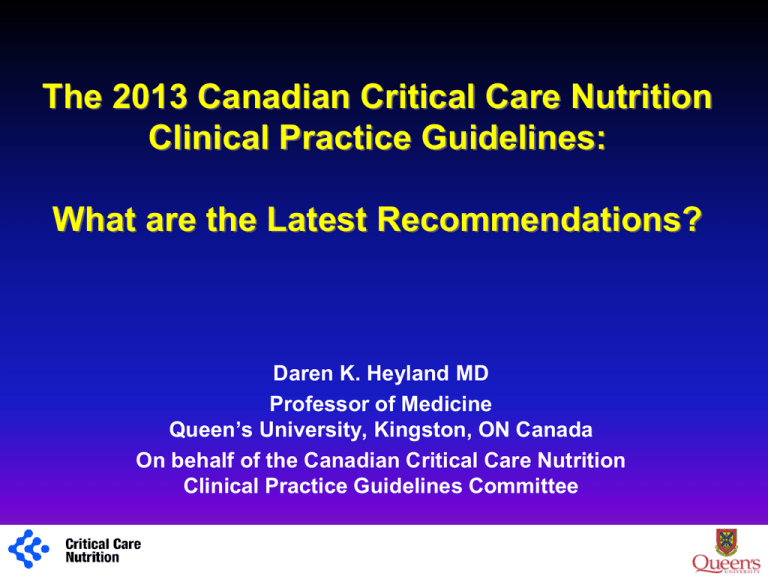
The 2013 Canadian Critical Care Nutrition
Clinical Practice Guidelines:
What are the Latest Recommendations?
Daren K. Heyland MD
Professor of Medicine
Queen’s University, Kingston, ON Canada
On behalf of the Canadian Critical Care Nutrition
Clinical Practice Guidelines Committee
1
Disclosures
I have received speaker honoraria and/or I have been
paid from grants from the following companies:
– Nestlé
– Fresenius Kabi
– Baxter
– Abbott
1
Learning Objectives
Better understand the process by which CPGs are developed
Become familiar with recent randomized nutrition trials in
critically ill adult patients
Enteral Fish oils
PN and type of Lipids
New Sections
Review the updated analyses and recommendations of the
Canadian CPGs
1
2005 update
2007 update
2009 update
Orginally published in 2003
2013
update
Summarizes 198 trials studying 21283 patients
34 topics
17 recommendations
www.criticalcarenutrition.com
Guideline Development
evidence
integration
of
values
+
practice
guidelines
Effect size
Confidence Intervals
Validity
Homogeneity
Adequacy of control group
Biological plausibility
Generalizability
Safety
Feasibility
Cost
Language of Recommendations
CONDITIONS
No reservations about endorsing
intervention.
Evidence supportive but minor
uncertainties about safety, feasibility, or
costs of intervention.
“recommend”
Supportive evidence weak and/or major
uncertainties about safety, feasibility, or
costs of intervention.
“ should be
considered”
Inadequate or conflicting evidence.
1
LANGUAGE OF
RECOMENDATION
“ strongly
recommend”
“ insufficient data”
Inclusion Criteria
Updated to 2013
•
•
•
•
1
Randomized controlled trials
Critically ill patients (not elective surgery)
Clinical Outcomes
EMBASE, Medline, Cinhal, reference lists
New Evidence
2009
2013
~240 RCTs
~275 RCTS
34 Topics
17
recommendations
45 Topics
22
recommendations
67 new RCTs across 27 topics!
New RCTs per Topic
Topic
2009
2013
Total
Enteral vs Parenteral
12
2
14
Early vs. delayed
14
2
16
Indirect Calorimetry
1
1
2
Arginine containing
24
2
26
Fish Oils/Borage Oils
4
4
8
Protein/peptides
4
1
5
Fibre
6
2
8
Small Bowel vs. Feeding
11
4
15
Probiotics
11
12
23
New RCTs per topic
Topic
2009
2013
Total
Combination EN + PN
5
3
8
PN Branched Chain A Acids
5
1
6
Intensive insulin
22
3
25
PN Type of lipids
5
4
9
PN Glutamine
17
11
28
Antioxidants
16
8
24
PN Selenium
11
7
18
New Topics (n=10)
New Topic
# RCTs
Intentional Underfeeding: Trophic vs Full Feeds
2
Intentional Underfeeding: Hypocaloric EN
1
Fish Oils only
1
Threshold of GRVs
2
Discarding GRVs
1
EN: ß Hydroxyl Methyl Butyrate (HMB)
1
Early Supplemental PN vs Late
1
PN + EN Glutamine
1
Optimal glucose control: CHO Restricted Formula +
Insulin Therapy
1
Vitamin D
1
Enteral Fish Oils*
*Product enhanced with fish oils +borage oils +
antioxidants
1
Enteral Fish Oils*
*Product enhanced with fish oils +borage oils + antioxidants
2009 Recommendation
Based on 5 studies, we recommend the use of
enteral formula with fish oils, borage oils, and
antioxidants in patients with ALI/ARDS
New RCTs = 4
Rice 2011
Grau-Carmona 2011
Thiella 2011
Elamin 2012
+ Pontes Arruda 2011
+ Stapleton 2011 (fish oil only)
NIH
NHLBI
Timing of Feeding
S
U
P
P
L
E
M
E
N
T
“Early
Full”
N-3 + GLA +
Antioxidants
(Module delivered
as bolus bid)
Control
Standard EN
(480 cal/ 20 g pro)
Fast ramp up
“Early
Trophic”
(10 ml/hr)
n = 250
n = 250
n = 250
n = 250
OMEGA: 60-Day Mortality
P=0.05
P=0.14
bolus: dilute effect?
50% pts underfed
(trophic)
protein in placebo
include but analyze
without
Rice et al JAMA Oct 2011
11 Spanish ICUs
89 patients with diagnosis of Sepsis on admission
Randomized to:
• Fish Oil/Borage Oil formula OR
• Standard polymeric formula
Outcomes: new organ dysfunction
Grau-Carmona Clin Nutr 2011
Clinical Outcomes
Fish Oils: Trend towards lower SOFA scores (NS)
First multicentre study to use “usual
care” in control group…….no effect on
mortality
Grau-Carmona Clin Nutr 2011
89 patients from 5 centres in US
Mechanically ventilated patients with Acute lung injury (ALI)
Randomized to (separate from EN):
• BOLUS fish oils 7.5 mls q 6 hrs, 9.75g EPA & 6.75 gm DHA/day
OR
• placebo i.e. normal saline X 14 days
EN or PN as per MDs discretion
Stapleton CCM 2011
Clinical Outcomes
Fish Oils ONLY
Bolus
Separate from EN
X aggregate with RCTs
of fish oil, borage oil
Stapleton CCM 2011
Fish Oils: Effect on mortality (n = 6)
INTERSEPT, Stapleton data not included
No effect , statistical heterogeneity!
2009: RR 0.67, 95% CI 0.51, 0.97, p = 0.003
Fish oils: effect on mortality removing
bolus RCT (n =5)
Significant effect, no statistical heterogeneity!
EN Fish oils with new RCTs
Effect on mortality disappears when bolus study is included
• statistical heterogeneity present
Effect on mortality is significant when bolus study excluded
Infections (2 RCTs): no effect
Reduction in ICU LOS still significant (heterogeneity)
Concerns of control group, negative results of large studies
2013 Recommendations
Fish Oils/borage oil: Downgraded recommendation to
“should be considered”
Fish Oils alone: insufficient data
Use of PN and type of lipids
1
EN + PN
Lancet 2012
Combined EN + PN
used indirect calorimetry
No difference mortality
reduced infections day 4-28
+ Abrishami 2010
+ Chen 2011
No change from 2009
we recommend that PN not be started
not be started at the same time as EN.
Insufficient evidence in those who are
not tolerating EN (case by case)
NEJM 2011
Early Supplemental PN vs. Late
large multicentre
early PN: worse infections, LOS
early PN: no diff mortality
high glucose loading
low risk patients
Strongly recommend that early PN & high IV
glucose not be used in low risk, short ICU stay
Insufficient evidence in those who are not
tolerating EN (case by case)
Lipid Free PN?
There are no new randomized controlled trials since the 2009 update
and hence there are no changes to the recommendation.
Recommendation:
• Based on 2 level 2 studies, in critically ill patients who are not
malnourished, are tolerating some EN, or when parenteral nutrition is
indicated for short term use (< 10 days), withholding soy bean
emulsions should be considered.
• There are insufficient data to make a recommendation about
withholding lipids high in soybean oil in critically ill patients who are
malnourished or those requiring PN for long term (> 10 days).
• Practitioners will have to weigh the safety and benefits of withholding
lipids high in soybean oil on an individual case-by-case basis in these
latter patient populations.
Soybean Oil (ω-6)
MCT
PN without Lipids
Olive Oil (ω-9)
Fish Oils (ω-3)
Vanek VW, et al. Nutr Clin Pract 2012; 27: 150.
High LCT
MCT/LCT
High MUFA
High PUFA
ω-6
50:50
Ω-9
Ω-3
Soybean Oil
(SO)
SO + Coconut
Olive Oil
(OO) + SO
Fish Oil (FO)
Lipofundin®
Intralipid®
(MCT/LCT)®
ClinOleic®
Omegaven®
Mixtures
SO, FO,
Coconut, OO
SMOF®
Lipoplus®
Study design
Randomized clinical,
parallel group, controlled
trials (RCT)
Population
Critically ill adult patients
(>18 years old)
Intervention
Parenteral strategies to
reduce soybean-oil vs. Ω-6
oil-based LE (LCT)
Pre-specified Outcomes
Mortality, ICU and Hospital
LOS, Infections
Omega-6 Reducing
LCT or LCT+MCT
Study or Subgroup
Events
Total
Events
Total Weight
1.1.1 LCT + MCT vs LCT
Garnacho-Montero
8
35
11
37 13.4%
Iovinelli
2
12
3
12
3.2%
Lindgren
1
15
0
15
0.8%
Nijveldt
2
12
1
8
1.7%
Subtotal (95% CI)
74
72 19.1%
Total events
13
15
Heterogeneity: Tau² = 0.00; Chi² = 0.94, df = 3 (P = 0.82); I² = 0%
Test for overall effect: Z = 0.53 (P = 0.59)
1.1.2 Fish oil containing emulsions vs LCT or LCT + MCT
Barbosa
4
13
4
10
Friesecke
18
83
22
82
Grecu
2
28
3
26
Wang 2009
0
28
2
28
Subtotal (95% CI)
152
146
Total events
24
31
Heterogeneity: Tau² = 0.00; Chi² = 0.89, df = 3 (P = 0.83); I² = 0%
Test for overall effect: Z = 1.16 (P = 0.25)
Risk Ratio
M-H, Random, 95% CI
0.77 [0.35, 1.69]
0.67 [0.13, 3.30]
3.00 [0.13, 68.26]
1.33 [0.14, 12.37]
0.84 [0.43, 1.61]
6.6%
27.9%
2.8%
0.9%
38.3%
0.77 [0.25, 2.34]
0.81 [0.47, 1.39]
0.62 [0.11, 3.41]
0.20 [0.01, 3.99]
0.76 [0.48, 1.21]
6.7%
1.9%
26.5%
7.5%
42.7%
1.00 [0.33, 3.02]
3.33 [0.42, 26.72]
0.89 [0.51, 1.55]
0.60 [0.21, 1.71]
0.90 [0.58, 1.39]
Total (95% CI)
409
394 100.0%
Total events
69
80
Heterogeneity: Tau² = 0.00; Chi² = 4.19, df = 11 (P = 0.96); I² = 0%
Test for overall effect: Z = 1.27 (P = 0.20)
Test for subgroup differences: Chi² = 0.25, df = 2 (P = 0.88), I² = 0%
0.83 [0.62, 1.11]
1.1.3 Olive oil containing emulsions vs LCT or LCT + MCT
Garcia de Lorenzo
4
11
4
11
Huschak
4
18
1
15
Pontes-Arruda 2012
19
103
21
101
Umperrez
5
51
8
49
Subtotal (95% CI)
183
176
Total events
32
34
Heterogeneity: Tau² = 0.00; Chi² = 2.14, df = 3 (P = 0.54); I² = 0%
Test for overall effect: Z = 0.49 (P = 0.62)
Ω-6 Sparing Strategies were associated with
a reduction in Mortality (RR= 0.83, 95 % CI
0.62, 1.11, P= 0.20, heterogeneity I2 =0%)
Risk Ratio
M-H, Random, 95% CI
0.01
0.1
1
10
100
Favours omega-6 reducing Favours LCT or LCT+MCT
Manzanares W, et al. Int Care Med 2013 (in press)
Omega-6 Reducing
LCT or LCT+MCT
Study or Subgroup
Mean
SD Total Mean
SD Total Weight
1.4.1 Fish oil containing emulsions vs LCT or LCT + MCT
Grecu
2.83
1.62
8
5.23
2.8
7 50.5%
Friesecke
22.8
22.9
83
20.5
19
82 16.4%
Barbosa
10
14.4
13
11 12.64
10
6.4%
Subtotal (95% CI)
104
99 73.3%
Heterogeneity: Tau² = 0.00; Chi² = 1.84, df = 2 (P = 0.40); I² = 0%
Test for overall effect: Z = 1.63 (P = 0.10)
1.4.2 Olive oil containing emulsions vs LCT or LCT + MCT
Huschak
13
8.9
18
20.4
7
Garcia de Lorenzo
11 11.93
11
13 16.25
Subtotal (95% CI)
29
Heterogeneity: Tau² = 0.00; Chi² = 0.65, df = 1 (P = 0.42); I² = 0%
Test for overall effect: Z = 2.57 (P = 0.01)
15
11
26
21.1%
5.6%
26.7%
Total (95% CI)
133
125 100.0%
Heterogeneity: Tau² = 3.00; Chi² = 5.36, df = 4 (P = 0.25); I² = 25%
Test for overall effect: Z = 1.72 (P = 0.09)
Test for subgroup differences: Chi² = 2.87, df = 1 (P = 0.09), I² = 65.2%
Mean Difference
IV, Random, 95% CI Year
Mean Difference
IV, Random, 95% CI
-2.40 [-4.76, -0.04] 2003
2.30 [-4.12, 8.72] 2008
-1.00 [-12.07, 10.07] 2010
-1.81 [-3.98, 0.36]
-7.40 [-12.83, -1.97] 2005
-2.00 [-13.91, 9.91] 2005
-6.47 [-11.41, -1.53]
-2.57 [-5.51, 0.37]
-100
-50
0
50
100
Favours omega-6 reducing Favours LCT or LCT+MCT
Ω-6 Sparing Strategies were associated
with a trend towards a reduction in
Ventilation Days
(WMD -2.57, 95% CI -5.51, 0.37, P=0.09)
Manzanares W, et al. Int Care Med 2013 (in press)
Omega-6 Reducing
LCT or LCT+MCT
Study or Subgroup
Mean
SD Total Mean
SD Total Weight
1.3.1 LCT + MCT vs LCT
Nijveldt
13.8
2.9
12
17.4
3
8 19.1%
Garnacho-Montero
16.6
6.1
35
15.8
7
37 18.3%
Subtotal (95% CI)
47
45 37.4%
Heterogeneity: Tau² = 7.57; Chi² = 4.59, df = 1 (P = 0.03); I² = 78%
Test for overall effect: Z = 0.67 (P = 0.51)
1.3.2 Fish oil containing emulsions vs LCT or LCT + MCT
Grecu
3.32
1.48
8
9.28
3.08
7
Friesecke
28
25
83
23
20
82
Barbosa
12
14.4
13
13
12.6
10
Subtotal (95% CI)
104
99
Heterogeneity: Tau² = 35.46; Chi² = 8.97, df = 2 (P = 0.01); I² = 78%
Test for overall effect: Z = 0.28 (P = 0.78)
1.3.3 Olive oil containing emulsions vs LCT or LCT + MCT
Garcia de Lorenzo
32.9
10.6
11
41.8
16.3
Huschak
17.9
11.2
18
25.1
7
Umperrez
17
18
51
15.2
14
Subtotal (95% CI)
80
Heterogeneity: Tau² = 21.46; Chi² = 4.90, df = 2 (P = 0.09); I² = 59%
Test for overall effect: Z = 1.16 (P = 0.25)
11
15
49
75
Mean Difference
IV, Random, 95% CI
-3.60 [-6.25, -0.95] 1998
0.80 [-2.23, 3.83] 2002
-1.46 [-5.77, 2.85]
19.4%
10.2%
5.5%
35.1%
-5.96 [-8.46, -3.46] 2003
5.00 [-1.90, 11.90] 2008
-1.00 [-12.06, 10.06] 2010
-1.13 [-8.96, 6.69]
5.2%
11.2%
11.2%
27.6%
-8.90 [-20.39, 2.59] 2005
-7.20 [-13.47, -0.93] 2005
1.80 [-4.51, 8.11] 2012
-4.08 [-10.97, 2.81]
Total (95% CI)
231
219 100.0%
Heterogeneity: Tau² = 10.21; Chi² = 21.87, df = 7 (P = 0.003); I² = 68%
Test for overall effect: Z = 1.53 (P = 0.13)
Test for subgroup differences: Chi² = 0.46, df = 2 (P = 0.80), I² = 0%
Ω-6 Reducing Strategies were
associated with a trend towards a
reduction in ICU LOS
(WMD -2.31, 95% CI -5.28, 0.66, P=0.13)
Mean Difference
IV, Random, 95% CI Year
-2.31 [-5.28, 0.66]
-100
-50
0
50
100
Favours omega-6 reducing Favours LCT or LCT+MCT
Manzanares W, et al. Int Care Med 2013 (in press)
LCT plus MCT versus LCT
Emulsions
No difference in Mortality
(RR= 0.84, 95 % CI 0.43, 30 2 31 1.61, P=0.59,
heterogeneity I =0%)
No difference in ICU LOS
(WMD -1.46, 95 % CI -5.77, 2.85, P= 0.51, heterogeneity was
present I2= 78%, P=0.03)
Ω9 Oil-based LE versus
Soybean Oil-based strategy
No difference between the groups in Mortality
(RR= 0.90, 95% CI 0.58, 1.39, P=0.62, heterogeneity I2= 0%)
Significant reduction in the duration of MV
(WMD -6.47, 95% CI -11.41, -1.53, P= 0.01, heterogeneity I2=0%)
No effect on ICU LOS
(WMD -4.08, 95 % CI - 10.97, 2.81, P=0.25, heterogeneity I2=59%)
0.71 (0.49,1.04)
P= 0.08
FO containing lipid emulsions were
associated with a trend towards a
reduction in mortality
RR= 0.71, 95 %CI 0.49-1.04, P= 0.08
Manzanares W, et al. JPEN 2013, in press.
-1.41 (-3.43,0.61)
P= 0.17
FO containing emulsions showed a
trend towards reduction in the duration
of MV days
WMD -1.41, 95% CI -3.43, 0.61, P=0.17
Manzanares W, et al. JPEN 2013, in press.
Which Alternative Lipid Emulsion to Use?
• No head to head trials (and not likely to be)
• We analyzed our International Nutrition Survey
database to evaluate effect of Alt Lipids on
outcomes.
• Analyzed adjusted for key confounding
variables.
Edmunds, Heyland (in submission)
1
Which Alternative Lipid Emulsion to Use?
Edmunds, Heyland (in submission)
1
Which Alternative Lipid Emulsion to Use?
Characteristic
Lipid-free Soybean oil
(n=70)
(n=223)
Age (yrs), mean±SD
64.8 ±16.6
63.5 ±15.9
Sex, n (%)
Male
Female
50 (71.4)
20 (28.6)
135 (60.5)
88 (39.5)
42 (64.6)
23 (35.4)
45 (60.8)
29 (39.2)
9 (47.4)
10 (52.6)
0.31
Body mass index (kg/m2), mean±SD
26.1 ±9.8
28.4 ±8.0
23.8 ±3.3
25.6 ±4.7
27.4 ±6.4
<0.001
Admission category, n (%)
Medical
Emergency surgical
Elective Surgical
34 (48.6)
23 (32.9)
13 (18.6)
65 (29.1)
118 (52.9)
40 (17.9)
20 (30.8)
31 (47.7)
14 (21.5)
21 (28.4)
35 (47.3)
18 (24.3)
3 (15.8)
15 (78.9)
1 (5.3)
0.011
APACHE II score, mean±SD
23.8 ±9.5
22.4 ±7.9
22.7 ±9.3
21.1 ±8.0
24.3 ±6.8
0.30
1036 ±428
1466 ±372
1287 ±313 1553 ±388 1517 ±385
<0.001
39 ±89
28 ±97
Mean daily total calories (PN + propofol), mean±SD 1084 ±472
1499 ±387
Mean daily calories from PN, mean±SD
Mean daily calories from propofol, mean±SD
MCT oil
(n=65)
Fish oil
(n=19)
pa
61.9 ±16.9 64.0 ±16.4 66.2 ±18.3
0.81
14 ±37
Olive oil
(n=74)
43 ±65
13 ±30
0.005
1306 ±326 1625 ±406 1532 ±398
<0.001
Edmunds, Heyland (in submission)
1
Which Alternative Lipid Emulsion to Use?
Fish Oil
Olive Oil
Lipid Free
MCT
Soybean
Edmunds, Heyland (in submission)
1
PN Type of Lipids
2009 Recommendation
There are insufficient data to make a recommendation on the
type of lipids to be used in critically ill patients receiving
parenteral nutrition.
2013 Recommendation:
IV lipids that reduce the load of omega-6 fatty acids/soybean
oil emulsions should
be considered.
insufficient data on type of soybean
There are
reducing lipids
Other Topics
New Topic
RCTs
Recommendation
Intentional Underfeeding:
Hypocaloric EN
1
Insufficient data
Threshold of GRVs
1
Insufficient data (250-500ml)
Discarding GRVs
1
Insufficient data
EN: ß Hydroxyl Methyl Butyrate
(HMB)
1
Insufficient data
Optimal glucose control: CHO
Restricted Formula + Insulin
Therapy
1
Insufficient data
Vitamin D
1
Insufficient data
Summary
• Many recent RCTs in area of critical care nutrition
• Careful review of the articles is recommended
• Recommendations downgraded
EN Fish Oils/borage oils
PN Glutamine
• Recommendations upgraded
Probiotics
Type of PN lipids
• Recommendations do not change
Combined AOX
PN Selenium and others
• New Recommendations
PN + EN Glutamine: strongly recommended NOT to be used
Early PN vs Delayed PN: Strongly recommend NOT be used
Other: Trophic vs full feeds: should NOT be considered
Updated recommendations will have an impact on practices in ICU
Acknowledgment
Canadian Clinical Practice
Guidelines Committee
Co Chair Daren Heyland
Leah Gramlich
John Drover
Brian Jurewitsch
Carmen Christman
Chelsea Corbett
Jan Greenwood
Michele McCall
Gwynne Macdonald
Guiseppe Pagliarello
Jim Kutsogiannis
John Muscedere
Khursheed Jeejeebhoy
Courtney Somers-Balota
Dominique Garrel
Adam Rahman
William Manzanares
Paul Wischmeyer
Rene Stapleton
Todd Rice
Andrew Davies
Emma Ridley
1

